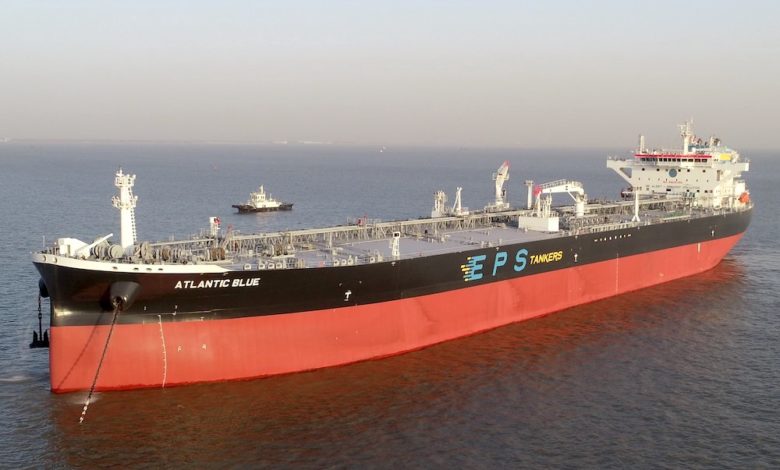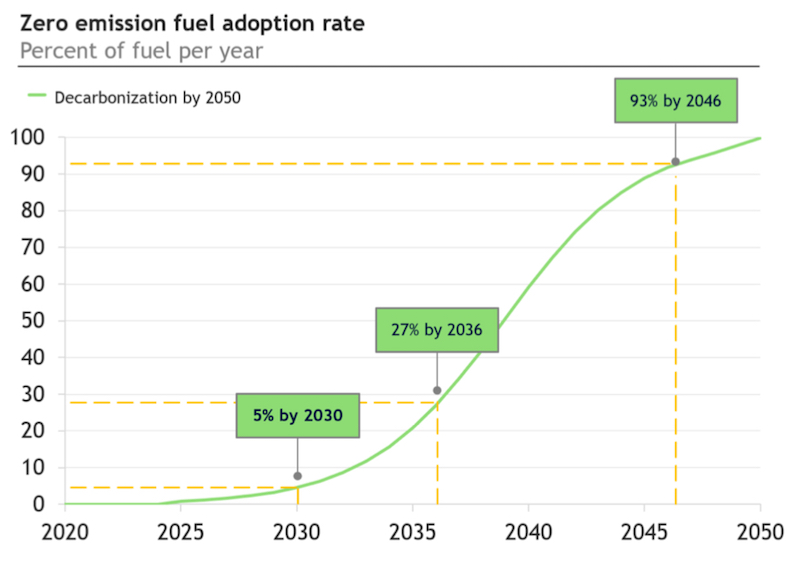Shipping’s Paris path detailed in new zero emission fuels study

At what degree of adoption do zero emission fuels become commercially viable for international shipping? Important analysis released today by UMAS and the COP26 Climate Champions for the Getting to Zero Coalition suggests that zero emission fuels need to make up 5% of the international shipping fuel mix by 2030 to enable decarbonisation in line with Paris Agreement goals.
Today’s report, penned by Peder Osterkamp, shipping lead at COP26 Climate Champions, Dr Tristan Smith, reader in energy and shipping, University College London and Kasper Søgaard, head of research at the Global Maritime Forum, will be eagerly read by shipping lines actively thinking of placing their first orders for new fuelled ships.
The ambition of the Getting to Zero Coalition is to have commercially viable zero emission vessels operating along deepsea trade routes by 2030. The analysis looks at what degree of adoption it will take for zero emission fuels to become commercially viable. An S-curve based analysis (see chart below) suggests that zero emission fuels need to make up 5% of the international shipping fuel mix by 2030 to enable decarbonisation in line with Paris goals.
We expect that this study will become a reference point in the conversation around shipping decarbonisation
The adoption of zero emission fuels in shipping is bound to follow an S-curve, the authors state, as has been the case with all historical industrial transformations. An S-curve consists of three phases. It starts with a slow emergence phase, when there is rapid learning and the costs start to come down. After this, the diffusion phase starts with rapid adoption of the new technology, with positive feedback loops between different actors raising confidence, increasing demand and investment throughout the value chain. The curve flattens out again in the reconfiguration phase as the new technology is adopted and a new normal is established.
To estimate the tipping point shipping needs to achieve by 2030 for rapid diffusion of zero emission technology thereafter, the researchers generated an S-curve to fit the UMAS 2036 and 2046 milestones. These establish that to reach decarbonisation by 2050, zero emission fuels need to represent 27% of total energy by 2036, and 93% by 2046. Though the Getting to Zero Coalition has not yet aligned on a target year for full decarbonisation, it said today it prefers to have a 2030 target that enables decarbonisation in line with the Paris Agreement. The resulting curve indicates the need for a 5% adoption rate of zero emission fuels by 2030.
There are three primary subsegments of shipping that could move first and achieve this 5 percent target, the new research suggests.
Container shipping is viewed by the research team as the first shipping sector to start to decarbonise as a few ports/routes account for a large share of volume, and the sector is closer to the end consumer. For example, 10 large deepsea routes accounted for 7m tons of CO2 in 2018. These 10 routes could make up 0.8% of the total 5% needed.
“If ammonia is selected, ammonia and LPG tankers are well suited to be first movers, as storage, systems and crew are well adapted to this fuel,” the report stated. This could also cover other ships used to transport other hydrogen-derived fuels. Ammonia transport alone accounted for approximately 0.1% of emissions in 2018. Together with LPG tankers, the sum could be 2% of the total 5% needed.
Niche non-container international routes with a high likelihood of having enabling conditions for first movers of zero emission fuels – for example Chile-US, Japan-Australia, Dubai- Singapore, Australia-Singapore, Denmark-Norway – could provide another 2%, the researchers suggested. In addition, domestic shipping could account for another 2 to 3%.
The Getting to Zero Coalition’s definition of ‘zero carbon energy sources’ is intended to be inclusive of fuels derived from zero carbon electricity, biomass and the use of carbon capture and sequestration. It excludes, however, energy sources derived from carbon capture and utilisation based on the combustion of fossil fuels. The definition includes green hydrogen and its derivatives, such as ammonia and methanol, blue hydrogen and its derivatives, as well as sustainable biofuels.
“In terms of scalability, the hydrogen-derived fuels have the biggest long-term potential for rapid scaling in the following decades and should be a significant part of the 2030 fuel mix,” the report states.
UMAS estimates that the overall energy need for shipping will be 12.9 Exajoules in 2030. 5% of this amounts to 0.64 Exajoules, or 15.8m tons of heavy fuel oil equivalent. Assuming that the hydrogen-based fuel used is ammonia, to produce it in this amount would require roughly 60 GW of green hydrogen electrolyzer capacity, something the research team insisted today was possible.
The report’s authors called on charterers to give important demand signals by committing to use zero emission fuels where available at a certain premium.
“The need for a rapid deployment of capital and low cost long-term investments requires institutional investors and IMO regulation in line with Paris targets focusing both on operational efficiency measures and on incentives to adopt zero emission fuels,” the report states.
“We expect that this study will become a reference point in the conversation around shipping decarbonisation in line with our one trillion-dollar infrastructure investment study,” a spokesperson for the Global Maritime Forum, a partner of the Getting to Zero Coalition, told Splash, referring to a landmark study released in January last year that looked at the costs involved in getting the land-based and ship-related infrastructure in place to halve international shipping’s greenhouse gas emissions by 2050 compared to 2008 levels, as per the mandate of the International Maritime Organization (IMO).
This year has seen plenty of first mover developments as the future fuels debate shifts a gear with leading owners such as Eastern Pacific, Hartmann and Maersk making moves for breakthrough ammonia-fuelled ships.

